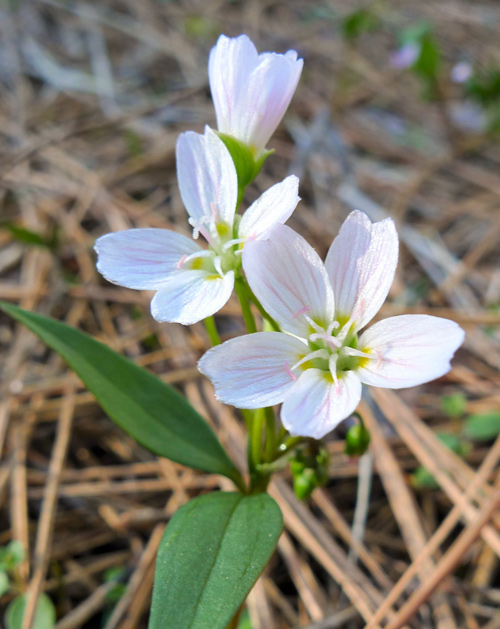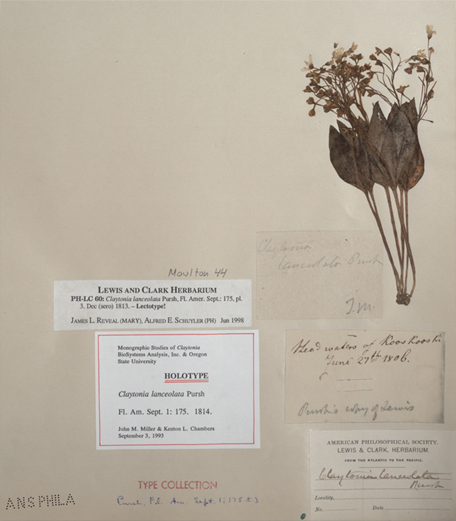Western Spring Beauty
Claytonia lanceolata
© 2013 by Thayne Tuason. Permission to use granted under the Creative Commons Attribution-Share Alike 4.0 International license.
On 22 August 1805, George Drouillard had brought Lewis three roots that he had claimed as booty after a chance encounter with a family of Lemhi Shoshone Indians. One was the bitterroot, one was an edible valerian. The third was the one that impressed him most, and he proceeded to describe it with considerable interest. It was, he wrote:
about the size of a nutmeg, and of an irregularly rounded form, something like the smallest of the Jarusolem artichoke, which they also resemble in every other appearance. they had become very hard by being dryed these I . . . boiled agreeably to the instruction of the Indians and found them very agreeable. they resemble the Jerusalem Artichoke very much in their flavor and I thought them preferable, however there is some allowance to be made for the length of time I have now been without vegitable food to which I was always much attatched. these are certainly the best root I have yet seen in uce among the Indians.
Lewis’s Specimen
He asked the Indians who were camped with his party at Fortunate Camp to show him the plant that grew from the root, and was told they did not grow thereabouts. The following spring, he came upon it again. On 25 June 1806, on the branch of Hungery Creek where they “nooned it,” Sacagawea brought the captains “a parcel of roots” that Lewis immediately recognized as the kind Drouillard had given him ten months earlier. Once more Lewis compared it, “in flavor an consistency,” with the Jerusalem artichoke. Then he dropped some important clues to its true identity. It had, he said, “two small oval smooth leaves placed opposite on either side of the peduncle just above the root. the scape is only about 4 inches long is round and smooth.” Undoubtedly this was the western spring beauty, Claytonia lanceolata. Two days later he collected a specimen, somewhere near Bald Mountain, if the date on the specimen sheet is correct.
The Swedish biologist Carl Linneaus (1770-78) already named a genus Claytonia (clay-TONE-ee-uh) for the early Virginia naturalist John Clayton (1694-1773).[1]Paul Russell Cutright, Lewis and Clark: Pioneering Naturalists (Lincoln: University of Nebraska Press, 1989), 157–58. This species was first described and named, and placed under Linneaus’s genus, by Frederick Pursh in 1813. The term lanceolata (lan-see-oh-LAY-tuh) refers to the lance-shaped—not oval—leaves. Eaten raw, this tuber—actually a corm, or underground stem—is said to taste like a radish, but when properly cooked, its flavor and texture resemble that of a baked potato.
Notes
| ↑1 | Paul Russell Cutright, Lewis and Clark: Pioneering Naturalists (Lincoln: University of Nebraska Press, 1989), 157–58. |
|---|
Experience the Lewis and Clark Trail
The Lewis and Clark Trail Experience—our sister site at lewisandclark.travel—connects the world to people and places on the Lewis and Clark Trail.
Discover More
- The Lewis and Clark Expedition: Day by Day by Gary E. Moulton (University of Nebraska Press, 2018). The story in prose, 14 May 1804–23 September 1806.
- The Lewis and Clark Journals: An American Epic of Discovery (abridged) by Gary E. Moulton (University of Nebraska Press, 2003). Selected journal excerpts, 14 May 1804–23 September 1806.
- The Lewis and Clark Journals. by Gary E. Moulton (University of Nebraska Press, 1983–2001). The complete story in 13 volumes.




